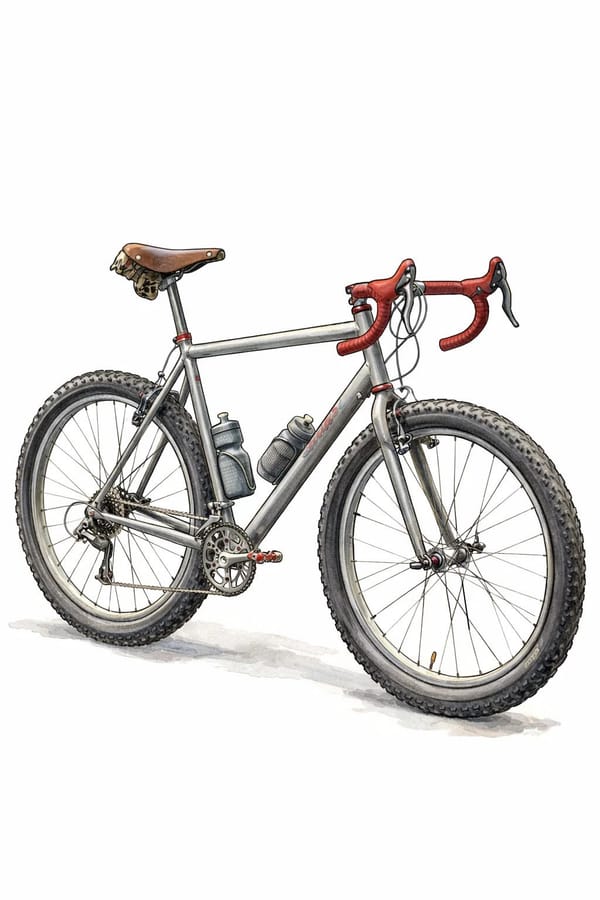Weekly Briefing - More Carbs, Recovery, Perfecting the Pain Cave

Welcome to this week's edition of Gear & Grit, where we dissect the science and strategy that make you a faster, stronger, and smarter cyclist. This week, a single, powerful theme emerges from the latest research, gear releases, and expert discussions: adaptation. It’s the biological magic that turns stress into strength, the process that allows our muscles to rebuild more powerfully after a hard session. But adaptation extends far beyond our physiology.
The Science of Fuel: Pushing Past the 90g/hr Carb Barrier
For years, the golden rule of endurance fueling was to consume between 60 and 90 grams of carbohydrates per hour. This figure was treated as a physiological ceiling, the maximum amount the human gut could reasonably absorb during intense exercise. However, the science of sports nutrition is in a constant state of evolution, and the latest professional strategies are shattering that ceiling. Elite cyclists and triathletes are now successfully utilizing intakes of 100-120 grams of carbohydrates per hour, and in some cases even more, to fuel their longest and hardest efforts. This isn't just about eating more; it's about unlocking a new level of performance by fundamentally changing the way we think about fueling.
Fueling as the Fourth Discipline
The primary barrier to consuming such high quantities of carbohydrates is not desire, but digestive tolerance. Shoveling in 120 grams of sugar an hour without preparation is a recipe for gastrointestinal disaster. This reality has given rise to a new performance paradigm: nutrition is no longer a passive support system but an active, trainable component of performance, as critical as any interval session. To successfully implement a high-carb strategy, athletes must undertake dedicated "gut training" to improve their tolerance and absorption capacity.
This process involves gradually increasing carbohydrate intake during training sessions over a period of weeks or months, teaching the digestive system to handle a greater load. It requires the same principles of progressive overload that we apply to our physical training. An athlete shouldn't jump from 60g/hr to 120g/hr on race day. Instead, a periodized nutrition plan should mirror the structure of a training plan. During base miles, one can practice with lower carb rates and a mix of real foods. As the training moves into build and peak phases, the hourly carb rate should be progressively increased during key long rides, using the specific gels, drinks, and chews planned for race day. This methodical adaptation elevates fueling from a simple act of consumption to a trainable physiological system—effectively, the fourth discipline of endurance sport.
The Science of Absorption: Ratios and Timing
Successfully pushing past the 90g/hr barrier hinges on understanding how our bodies absorb carbohydrates. The gut has specific transporters for different types of sugar. The transporter for glucose (SGLT1) becomes saturated at an intake rate of about 60g/hr. To absorb more, a second type of sugar that uses a different transporter (GLUT5 for fructose) must be introduced. This is why advanced sports nutrition products utilize multiple transportable carbohydrates, typically a blend of glucose (or its polymer, maltodextrin) and fructose. For intakes up to 90g/hr, a 2:1 glucose-to-fructose ratio is effective. For the new frontier of 100-120g/hr, emerging research suggests a 1:1 ratio may be even more effective at maximizing absorption and minimizing distress.
Equally important is the timing of consumption. The gut handles a steady drip-feed of fuel far better than a sudden deluge. A common mistake is to wait until the top of the hour to consume a large amount of fuel at once. A more effective strategy is to break down the hourly goal into smaller, frequent feedings. Taking a sip from a carb-rich bottle every 5-10 minutes and consuming a gel or a portion of a bar every 15-20 minutes keeps energy levels stable and is far gentler on the digestive system.
Fueling for the Ride: A Two-Part Strategy
While high-carbohydrate fueling is essential for high-intensity performance, it's not the optimal strategy for every ride. High carbohydrate intake spikes insulin, which actively suppresses fat oxidation—the body's ability to burn fat for fuel. For long, low-intensity endurance rides in Zones 1 and 2, the goal is often to improve this very metabolic pathway. On these rides, deliberately consuming fewer carbohydrates and focusing on fat and protein sources before the ride can enhance the body's fat-burning adaptations.
This creates a dual-system approach for the modern endurance athlete:
- Low-Intensity Training: Fuel with high-fat or protein foods beforehand (e.g., eggs and avocado) to train fat metabolism.
- High-Intensity Training & Racing: Fuel with high-carbohydrate meals beforehand (e.g., oats with berries) and consume 60-120g/hr of multiple transportable carbohydrates during the session to maximize performance.
This periodized approach to daily nutrition ensures that both of the body's critical energy systems are being trained effectively, creating a more metabolically flexible and robust athlete.
Post-Ride Recovery: Rebuild and Replenish
The clock starts on recovery the moment you step off the bike. The primary goal is to replenish the muscle glycogen stores that were depleted during the ride. To do this effectively, a rapid intake of carbohydrates is crucial, especially if another training session is scheduled within the next 8 hours. The scientific consensus points to a target of 1.0–1.2 g/kg of body weight per hour for the first 4 hours post-exercise.
Pairing these carbohydrates with a high-quality source of protein accelerates recovery by initiating muscle protein synthesis—the process of repairing and rebuilding muscle tissue. Aim for at least 0.3 g/kg of body weight, or a total of 20-40 grams of protein, in your post-ride meal or shake. A simple and effective recovery meal for a 150-pound (68kg) athlete could be a chicken wrap or a recovery shake containing approximately 55-80 grams of carbohydrates and 20-25 grams of protein.
Training Room: Building Gravel-Ready Power & Road Race Sharpness
A successful season is built not on heroic one-off efforts, but on the relentless accumulation of well-executed workouts. The cornerstones of any effective training plan are consistency and progressive overload—the principle of gradually increasing training stress to stimulate adaptation. A widely used and effective structure for achieving this is organizing training into blocks, typically involving three weeks of building load followed by one week of recovery and adaptation.
A well-rounded training week should be a carefully balanced ecosystem of stress and rest, incorporating several key elements:
- The Long Ride: This is the foundation of endurance. These rides should be performed at a steady, conversational intensity (around 60-80% of maximum) and gradually increase in duration from week to week.
- High-Intensity Sessions: To raise your ceiling of performance, you need to push against it. One or two sessions per week should incorporate intervals designed to improve your speed and power. These can include hill repeats, steady-state tempo or sweetspot efforts, or shorter, high-intensity intervals.
- Recovery & Rest: Fitness gains are not made during the workout, but during the recovery that follows. At least one full day off the bike per week is essential, supplemented by active recovery rides—short, very low-intensity spins designed to promote blood flow without adding training stress.
The Convergence of Disciplines
While the demands of a technical gravel race and a fast road criterium may seem worlds apart, the underlying physiological engines are remarkably similar. Modern training plans for both disciplines are built on the same fundamental principles. Where they diverge is in the emphasis of specific workouts.
A gravel-focused plan, for instance, might place a premium on workouts that build muscular endurance and high-torque strength. An excellent example is the "Overgear" workout, which involves performing intervals at a low cadence (e.g., 50-60 rpm) in a large gear. This builds the raw strength needed to power up steep, loose climbs while seated. Another staple is the "Sweetspot" workout, which involves sustained efforts at an intensity just below your functional threshold power (FTP), typically 88-94%. This is brutally effective at raising your sustainable power, a critical attribute whether you're facing a 100-mile gravel grinder or a long breakaway on the road.
The modern, versatile cyclist understands that these workouts are not mutually exclusive. Incorporating gravel-specific sessions like overgear intervals into a road-focused plan can build a more robust power profile, improving seated climbing and breakaway speed. Conversely, the high-end speed work from a road plan can provide the punch needed to attack out of a corner in a gravel race.
Recovery: The Amateur's Most Important Workout
Professional cyclists recover faster from injury and training for a simple reason: recovery is their full-time job. They operate within a "monastic lifestyle" free from external stress, supported by a team of doctors, physios, and nutritionists who manage every aspect of their recuperation.
Amateur athletes, juggling training with careers, family, and life's other stressors, do not have this luxury. This means that for an amateur, recovery must be even more deliberate and prescriptive. While some athletes prefer to rest intuitively, taking a day off only when they feel they need it, this approach is fraught with risk for the typical Type-A cyclist who is more likely to do too much than too little.
For this reason, adopting a structured recovery model, like the classic "3 weeks on, 1 week off" block, provides an essential guardrail against overtraining. It forces rest before the body reaches a state of deep fatigue, allowing for the supercompensation that leads to fitness gains. Think of the recovery week not as a break from training, but as the most important training week of the month—the week where the actual adaptation happens.
The Pain Cave: Making Every Indoor Minute Count
The indoor trainer has evolved from a tool of last resort into a precision instrument for performance enhancement. To make the most of it, however, requires a shift in mindset and a focus on a few key details that are often overlooked.
The single greatest limiter of indoor performance is heat. Without the constant airflow of outdoor riding, body temperature skyrockets, heart rate drifts upward, and the ability to produce power plummets. To combat this, robust cooling is not a luxury; it is a necessity. A single, small fan is insufficient. A high-volume setup with one or more large fans is essential to replicate the cooling effect of riding outdoors and allow you to complete workouts effectively.
With a controlled environment, the trainer becomes the perfect laboratory for targeted physiological work. It eliminates variables like traffic, terrain, and stoplights, allowing for the uninterrupted execution of structured workouts. This makes it a far superior tool for specific tasks compared to riding outdoors.
- Precision Intervals: Whether it's a 20-minute sweetspot effort or a set of 30-second VO2 max intervals, the trainer allows for perfect execution at the prescribed power targets.
- Gut Training: Practicing a high-carbohydrate fueling strategy is far easier and more controlled indoors, with nutrition and hydration within arm's reach.
- Form and Cadence Work: The trainer is the ideal place to focus on maintaining a smooth, efficient pedal stroke at various cadences without distraction. A key focus should be on generating power from a stable, seated position, as excessive rocking or "penduluming" out of the saddle is an inefficient waste of energy.
By viewing the trainer not as a compromise but as a specialized tool, every minute spent in the pain cave can be a direct investment in outdoor speed.
The Weight Room: In-Season Strength, Simplified
For many cyclists, the question of how to integrate strength training during the competitive season is a source of confusion. The fear of creating excess fatigue or muscle soreness often leads to abandoning the gym altogether, but this is a mistake. In-season strength training is critical for injury prevention, maintaining neuromuscular power, and preserving bone density. The key is to shift the goal from building new strength to maintaining the strength built during the off-season.
The "Hard Days Hard" Principle
The most effective way for a time-crunched athlete to schedule in-season lifting is to stack it on the same day as a high-intensity ride. This consolidates the body's most stressful activities into a single day, allowing for more complete recovery on the subsequent easy or rest days. This "hard days hard, easy days easy" approach prevents the chronic, low-level fatigue that can result from spreading stress too evenly across the week. The ideal schedule involves performing the high-intensity ride in the morning, followed by the strength session in the afternoon or evening, with at least three hours separating the two workouts to allow for partial recovery.
During the season, the volume of lifting should decrease significantly to one or two sessions per week. The intensity, however, can and should remain high. This means lifting relatively heavy weights for a low number of repetitions, which maintains strength and power without creating the muscle damage and soreness associated with high-volume hypertrophy work.
In the final week before a major event, strength training should be reduced to a single, very low-volume session performed 2-3 days before the race. This workout should consist of just a few sets of your main lifts, performed with heavy weight but well short of failure (an RPE of 7-8 out of 10). This acts as a neuromuscular primer, keeping the body feeling sharp and powerful without inducing fatigue.
Sample In-Season Maintenance Strength Workout
This simple, effective workout can be completed in 30-45 minutes and targets the key muscle groups for cycling performance and stability. Focus on controlled movements and perfect form.
| Exercise | Sets x Reps | Key Focus for Cyclists |
| Goblet Squat or RDL | 3 x 5-8 | Focus on hip hinge and glute activation. Maintain a flat back.15 |
| Dumbbell Split Squat | 3 x 8-12 (each side) | Drive through the front heel to target glutes and quads. Crucial for single-leg power.16 |
| Glute Bridge | 2 x 12-15 | Squeeze glutes at the top; avoid over-arching the lower back. Builds posterior chain power.16 |
| Renegade Row | 3 x 8-10 (each side) | Keep hips square to the floor. Builds core stability to prevent power loss from the torso.16 |
| Bird Dog | 2 x 10 (each side, slow) | Extend arm and opposite leg without any movement in the lower back. Enhances core control.16 |
Listen Up: Your Weekly Podcast Queue
To bridge the gap between the science we've discussed and its real-world application, this week's podcast selections offer a look inside the minds and training files of some of the world's best.
- (https://www.podbean.com/podcast-detail/8ukbh-398ac/Ask-a-Cycling-Coach-Podcast---Presented-by-TrainerRoad): What separates the very good from the truly elite? Pro gravel racer Alexey Vermeulen joins the TrainerRoad crew to discuss the subtle details that elevate performance, including the tactical nuances of racing as a marked rider. This is a masterclass in the mindset of a winner.
- (https://podcasts.apple.com/us/podcast/fast-talk/id1490521721): For the data-driven athlete, this episode is a must-listen. The Fast Talk Labs team sits down with the CEO of TrainingPeaks to discuss the evolution of training software, the rise of AI coaching, and what the future holds for how we track and analyze our performance. It provides crucial context for the tools many of us use every day.
- (https://podcasts.apple.com/za/podcast/ask-a-cycling-coach-podcast-presented-by-trainerroad/id1035433041): This episode is the perfect case study for everything discussed this week. Keegan Swenson breaks down his MTB Marathon World Championship victory, analyzing his power data from a staggering six-hour effort that averaged 5.0 W/kg. He covers his race strategy, bike setup, and the high-carbohydrate fueling plan that powered him to the rainbow jersey, showing exactly how the best in the world put these principles into practice.
The Final Mile
Adaptation is a patient process. It doesn't happen in a single ride or a single week. It's the result of consistent, intelligent stress followed by deliberate, high-quality rest. This week, we've explored how to apply that principle to every facet of your cycling life—from training your gut to handle more fuel, to structuring your training week for maximum gains, to maintaining strength deep into the season.
Your challenge for the week ahead is to choose one key takeaway and put it into action. Maybe it's trying a structured, higher-carb fueling strategy on your next indoor trainer session. Perhaps it's adding a set of glute bridges to your post-ride routine. Or maybe it's simply giving yourself permission to take that recovery day truly easy. Pick one thing, apply it consistently, and let the adaptation begin.





